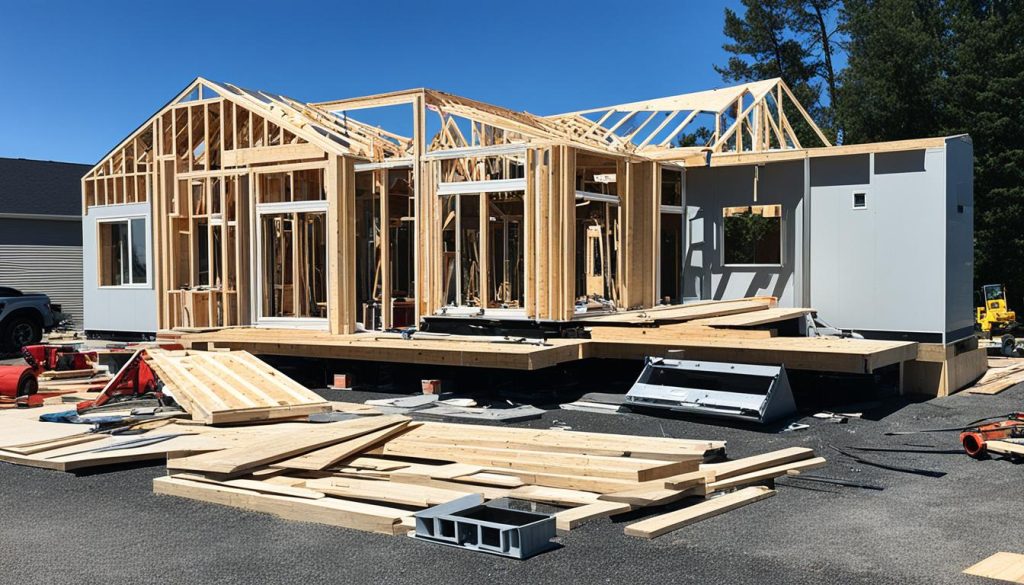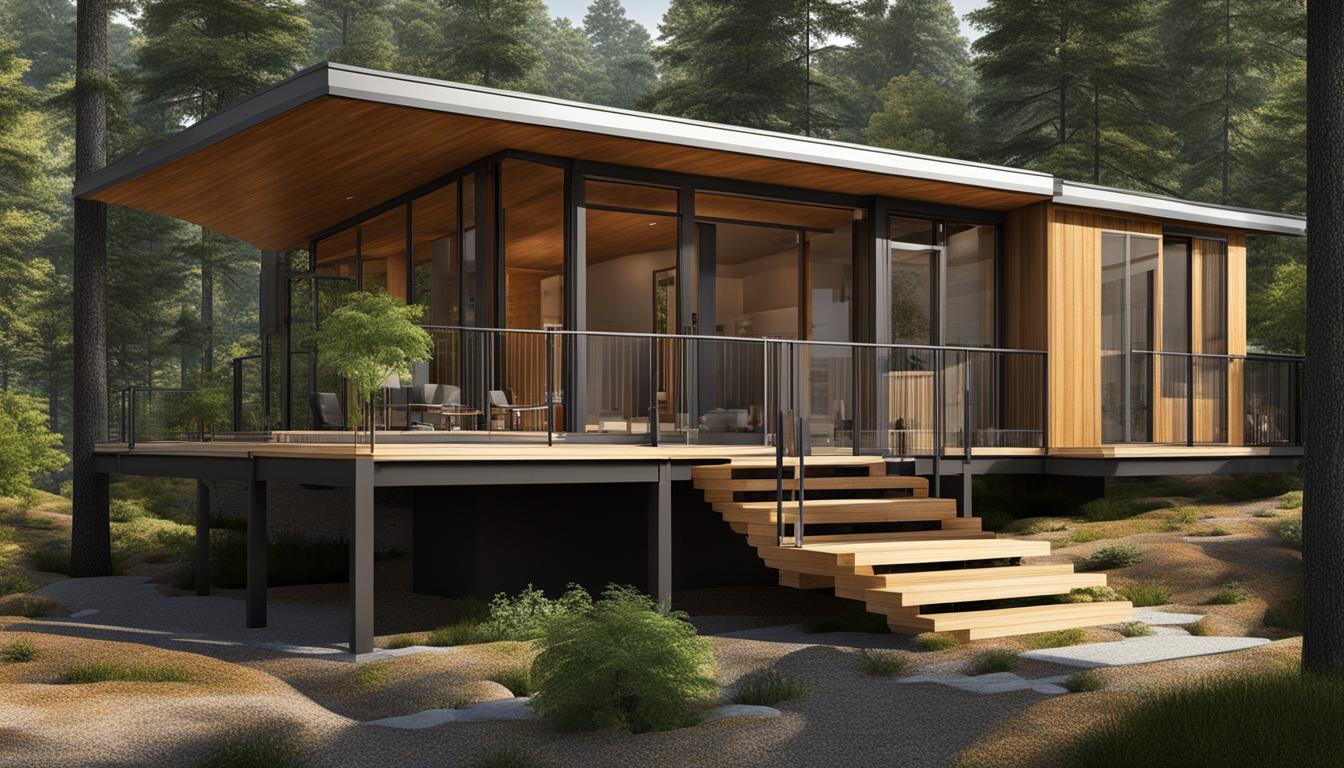Did you know that modular homes have become increasingly popular in Canada, with an estimated 10-15% annual growth in the past decade?1 However, despite their benefits, homeowners and builders often encounter various challenges when it comes to modular construction. From design and pre-construction considerations to fabrication and production hurdles, understanding these common problems is essential for a successful modular home project.
In this article, I’ll explore the key challenges faced throughout the modular home construction process and provide valuable insights on how to overcome them. Whether you’re a homeowner planning to build a modular home or a builder looking to improve your processes, this guide will help you navigate the potential pitfalls and ensure a smoother journey towards your dream home.
Key Takeaways:
- Modular homes have seen significant growth in Canada, but they come with their own set of challenges.
- Design and pre-construction considerations can pose limitations and require collaborative efforts.
- Manufacturing and production processes may face restrictions, with module transportation requiring careful planning.
- Remote site construction can present communication and logistical obstacles.
- Sequencing delays, module delivery issues, and documentation challenges can impact project timelines.
Now, let’s dive deeper into the details of each challenge and explore effective strategies for overcoming them.
Sources:
1Statistics Canada, Residential Construction Industry Survey, 2020.
Challenges in Design & Pre-Construction
Designing a modular home poses unique challenges that require careful consideration before construction begins. From the initial design phase to pre-construction preparations, understanding the limitations and requirements of modular construction is crucial to ensure a successful project.
Modular Home Design Challenges
When designing a modular home, there are specific constraints that must be taken into account. These include limitations on module width and height, as well as the need for standardized modules. These design restrictions can impact the layout and overall functionality of the home. For example, strategic placement of elements like bathrooms and utility areas is essential to maximize space and ensure a smooth assembly process.
Pre-Construction Considerations
Before the construction of a modular home can begin, various pre-construction considerations must be addressed. These may include site evaluation and preparation, obtaining necessary permits and approvals, and coordinating with suppliers and contractors. Ensuring that these pre-construction tasks are completed accurately and efficiently sets the foundation for a successful modular home project.
In addition, understanding the limitations of modular construction is vital. While modular homes offer numerous benefits, such as shorter construction timelines and improved quality control, there are certain trade-offs. For instance, customization options may be limited compared to traditional stick-built homes, and specific architectural features may be more challenging to achieve.
Collaboration between homeowners, architects, and modular contractors is essential to overcome these design challenges and leverage the advantages of modular construction. By working together, they can find innovative solutions and design modifications that meet both aesthetic vision and modular design requirements.
Overall, the challenges in design and pre-construction for modular homes require careful planning, collaboration, and a thorough understanding of the limitations and requirements of modular construction. By addressing these challenges head-on, homeowners and builders can create beautiful, functional, and efficient modular homes that meet their unique needs and preferences.
Obstacles in Fabrication & Production
Modular production requires careful attention to overcome various challenges in fabrication and production. While the controlled factory environment offers several advantages, it also presents certain limitations and considerations that need to be addressed.
Modular Fabrication Challenges
Modular fabrication involves the manufacturing and assembly of individual modules that will eventually form a complete structure. One of the challenges in this process is that workers specialize in specific tasks, which can make major design or construction changes challenging.
For example, if a significant design modification is required, it may result in delays and disruptions as workers need to transition from their assigned tasks to accommodate the changes. This highlights the importance of careful planning and coordination to minimize the impact on the overall production timeline.
Production Limitations
In modular construction, the standardized modules are manufactured based on specific design requirements. This adherence to standardization helps ensure consistency and quality; however, it may also pose limitations when it comes to customization.
While some degree of customization is possible within the modular manufacturing processes, there are still constraints in terms of module size, dimensions, and structural considerations. These limitations need to be considered during the design phase to ensure the feasibility of the modular construction project.
Module Transportation and Assembly
Transporting and assembling the modular units on-site is another critical aspect of the fabrication and production process. Proper planning and coordination are required to ensure structural stability and meet safety standards.
The transportation of modular units may involve logistical challenges such as limited access to certain sites or navigating through narrow roads. Additionally, the assembly process should be meticulously executed to ensure proper alignment and connection between modules.
By addressing these obstacles in fabrication and production through careful planning, coordination, and effective communication, the modular construction industry can continue to thrive and deliver innovative and efficient building solutions.

Addressing Remote Site Issues
In modular construction, the use of remote module yards is common, but it can present challenges in terms of limited transparency and communication. When modules are located in remote areas, it becomes more difficult to maintain a clear view of the fabrication and production process. Lack of visibility can lead to delays in decision-making and problem-solving, affecting the overall project timeline.
Moreover, coordinating transportation and logistics for modules in remote locations can be complex. The distance and terrain limitations may require additional planning and coordination to ensure safe and timely delivery. Overcoming transportation challenges is crucial to prevent delays and keep the project on track.
Another significant issue in remote site construction is communication barriers. The physical distance between the module yard and the construction site can hinder effective communication among stakeholders. Clear and constant communication is essential to address design changes, resolve issues, and maintain project progress.
To overcome these remote site issues, collaboration between all parties involved in the project is crucial. Regular and transparent communication channels need to be established to ensure that all stakeholders are informed of the progress and challenges. Utilizing digital tools and project management software can help streamline communication and increase transparency.
A shared understanding of transportation limitations and remote construction challenges will facilitate the development of effective strategies. By acknowledging and addressing these concerns from the early stages, project teams can minimize setbacks and optimize the modular construction process in remote locations.

| Challenges | Solutions |
|---|---|
| Limited transparency in module yards | Establish regular communication channels to provide updates and overcome visibility challenges. Utilize digital tools and project management software to enhance transparency. |
| Challenges of remote site construction | Prioritize effective communication and collaboration among stakeholders. Develop strategies to mitigate transportation and logistics challenges specific to remote locations. |
| Communication barriers | Implement clear and constant communication channels between the module yard and the construction site. Utilize digital platforms for efficient communication and information sharing. |
| Transportation limitations | Plan and coordinate transportation logistics in advance. Consider the distance, terrain, and any potential constraints to ensure safe and timely module delivery. |
Sequencing and Documentation Challenges
Poor sequencing can lead to significant delays in modular construction projects, disrupting timelines and causing setbacks. It is crucial to carefully plan and coordinate the sequence of construction activities to ensure smooth progress. Any hiccups in sequencing can result in additional time and costs.
Module delivery issues and inaccurate assembly further compound the challenges faced in modular construction. If modules are not delivered as scheduled or if there are mistakes during assembly, it can disrupt the construction timeline and cause delays. Coordination between suppliers, contractors, and transporters is vital in ensuring the timely delivery and proper installation of modules.
Completing documentation and punch lists can be a complex task in modular construction. Inconsistencies or unresolved issues in the documentation can create confusion and hinder the progress of the project. Thorough and accurate documentation is essential to address punch list items effectively and ensure all required tasks are completed to meet quality standards and regulations.
Maintaining quality control throughout the construction process is paramount in modular construction. Rigorous inspections and adherence to industry standards are necessary to identify and address any manufacturing defects or construction issues. Regular quality checks at each stage of production and assembly are vital to avoid delays and deliver a successful modular home project.

Leave a Reply
You must be logged in to post a comment.